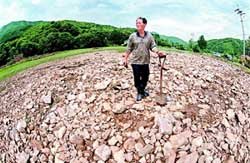Random development causes flooding damage
Random development causes flooding damage
Posted July. 23, 2000 22:15,

"Who will assume responsibility for this? They cut down many trees and razed the mountainside, creating this miserable picture," a village resident argued Sunday upon seeing some 20 houses flooded after torrential rains hit Kyonggi province Saturday. Other local residents of Sanghyon-ri, Suji County, Yongin City, Kyonggi province, an area where a housing project is underway, also exploded with anger at the terrible scene.
"All the floods in our village took place due to the construction of apartments. Before the mountainsides were cut off, these torrential rains could only raise the level of the stream slightly," Yang Chang-Sok said.
Since there are no trees on the mountain, rainwater ran down into the village, causing the devastation, he added.
Ms. Yun Kyong-Su, 41, whose greenhouse of about 500 pyong (1,650 square meters) was partially destroyed, said, "We asked the construction company to work out measures to prevent flooding yesterday, but they didn`t listen to us. Early this morning they just moved the construction materials piled along the stream."
Experts had warned several times that the random development project increased the possibility of flooding.
Cho Won-Chul, a professor of public works at Yonsei University, said he had warned of possible flood damage when he inspected the area with officials from a Chong Wa Dae flood disaster prevention planning team and other experts in June.
"I pointed out the apartment complex, which was being built with the mountainsides razed and small streams nearby buried, and warned that if the development continued without any preventative measures, torrential rains would cause a serious flood disaster."
One of the most serious problems was that greenspace and small streams were paved over or covered with concrete structures to prevent them from absorbing rainwater. As a result, the collected water could descend rapidly upon the village and unleash a possible flood.
Prof. Cho said, "An evaluation on how precipitation causes a flood at 80 places nationwide showed that the developed regions were unable to absorb rainwater. As a result, similar rainfall increased the total volume of rainwater by 60 to 70 percent." Concrete structures and asphalt roads play an especially significant role in the creation of a "flood expressway."
In case of golf courses, the volume of rainwater that should be disposed of increases by 10-30 percent because the land loses its ability to absorb rainwater, even though they have more greenspace than apartment complexes.
Prof. Cho said "The government plans to invest a total of 24 trillion won over the next 10 years to prevent flooding. But more effective than post-flood measures is checking the development of land and mountains by examining how the development will affect the environment in advance."
Headline News
- Presidential Office signals possible offensive weapons aid to Ukraine
- N. Korea reportedly prepares military balloon attack with Russia
- Medical associations join bipartisan talks on expanding medical school quotas
- Former world No. 1 Ko Jin-young returns to LPGA
- Kakao unveils AI service ‘Kanana’ at 'if Kakao AI 2024'







